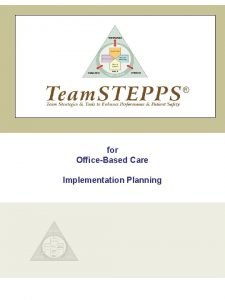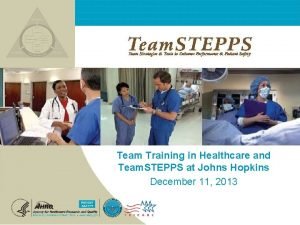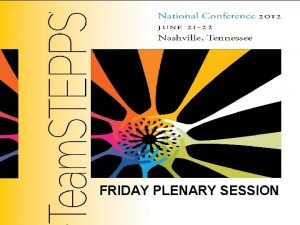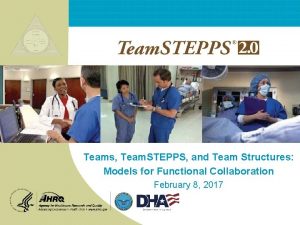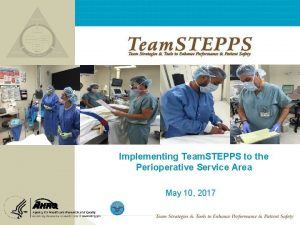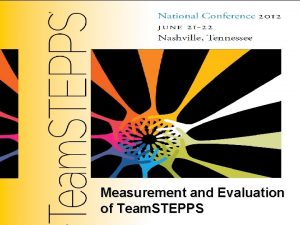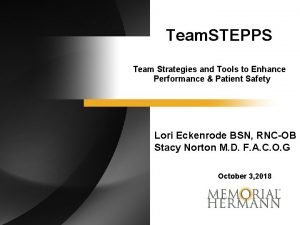Team STEPPS Tools Communication Qualities of Communication Provides





- Slides: 5

Team. STEPPS® Tools: Communication Qualities of Communication Provides brief, clear, specific, and timely information Seeks information from all available sources Call Out To request or provide information Cross Check Parroting requests for confirmation of understanding Check Back Closing the loop of communication Hand-Off Transfer of information during transitions SBAR Situation, Background, Assessment, Recommendation Ex. “Let’s give 1 mg Epinephrine IV now. ” Ex. “Order is 1 mg epinephrine IV now”; “Yes. ” Ex. “Just gave 1 mg epinephrine IV “; “O. K. ” Ex. “We gave 1 mg of Epinephrine IV, every 3 minutes with defibrillation x 2 until heart rate returned. ” Ex. Patient arrived in ED by ambulance with vfib. Patient is a 68 yr old man found unresponsive on the floor at home, wife called 911 and started CPR. No previous cardiac history. Heart rate returned after 2 rounds of epinephrine and defibrillation. Continue to monitor. Subscribe to our podcast “Better Healthcare Teams” at http: //rfu. ms/team


Team. STEPPS® Tools: Mutual Support Qualities of Mutual Support Team members protect each other from work overload Team members expect assistance will be actively sought and offered Task Assistance All offers and requests for assistance are in the context of patient safety Feedback is timely, respectful, specific, directed towards improvement, considerate Ex. “Do you want me to double check the patient’s weight so we order the correct dose of medication? ” Ex. “You did a great job of staying calm while intubating the patient. ” Advocacy and Assertion Language is firm and respectful, advocates for patient Two-Challenge Rule If you see something, say something (at least two times), may be used to “stop the line” Ex. “Please stop CPR. The patient has a Do Not Resuscitate order. ” Ex. “I think that is the wrong medication. Let’s stop and check. ” CUS I am Concerned! I am Uncomfortable! This is a Safety issue! DESC Describe the situation/behavior; Express how you feel or your concerns; Suggest alternatives/seek agreement; Consequences stated in terms of impact on team goals


Team. STEPPS® Tools: Leadership Effective Team Leader Responsibilities: Team leaders organize the team, articulate clear goals, communicate changes, provide needed feedback, manage resources, encourage others, facilitate conflict resolution, and model effective teamwork. Brief (beginning patient care) Short session at the beginning of an event to share the plan, discuss team dynamics, clarify roles and responsibilities, set goals, clarify expectations, identify possible contingencies, and anticipate outcomes. Huddle (during the middle) An ad hoc style meeting to affirm situational awareness, check in on plans already in place, and potentially to readjust the plan. Debrief (at the end) Used after an event is complete to exchange information designed to optimize team performance and effectiveness by considering lessons learned and identifying those strategies and behaviors that led to positive outcomes.
